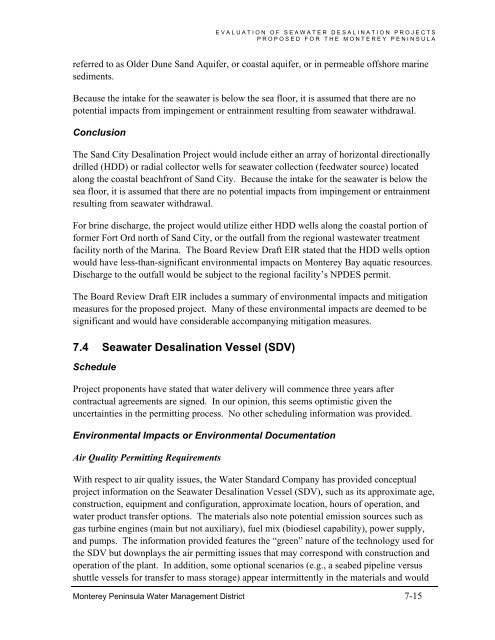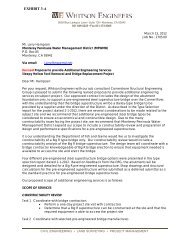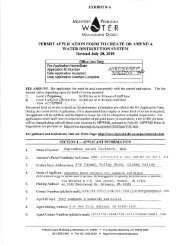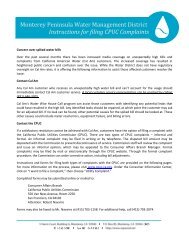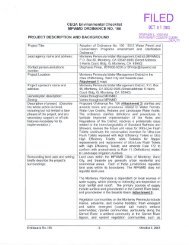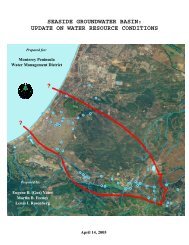FINAL REPORT Evaluation of Seawater Desalination Projects ...
FINAL REPORT Evaluation of Seawater Desalination Projects ...
FINAL REPORT Evaluation of Seawater Desalination Projects ...
Create successful ePaper yourself
Turn your PDF publications into a flip-book with our unique Google optimized e-Paper software.
EVALUATION OF SEAWATER DESALINATION PROJECTS<br />
PROPOSED FOR THE MONTEREY PENINSULA<br />
referred to as Older Dune Sand Aquifer, or coastal aquifer, or in permeable <strong>of</strong>fshore marine<br />
sediments.<br />
Because the intake for the seawater is below the sea floor, it is assumed that there are no<br />
potential impacts from impingement or entrainment resulting from seawater withdrawal.<br />
Conclusion<br />
The Sand City <strong>Desalination</strong> Project would include either an array <strong>of</strong> horizontal directionally<br />
drilled (HDD) or radial collector wells for seawater collection (feedwater source) located<br />
along the coastal beachfront <strong>of</strong> Sand City. Because the intake for the seawater is below the<br />
sea floor, it is assumed that there are no potential impacts from impingement or entrainment<br />
resulting from seawater withdrawal.<br />
For brine discharge, the project would utilize either HDD wells along the coastal portion <strong>of</strong><br />
former Fort Ord north <strong>of</strong> Sand City, or the outfall from the regional wastewater treatment<br />
facility north <strong>of</strong> the Marina. The Board Review Draft EIR stated that the HDD wells option<br />
would have less-than-significant environmental impacts on Monterey Bay aquatic resources.<br />
Discharge to the outfall would be subject to the regional facility’s NPDES permit.<br />
The Board Review Draft EIR includes a summary <strong>of</strong> environmental impacts and mitigation<br />
measures for the proposed project. Many <strong>of</strong> these environmental impacts are deemed to be<br />
significant and would have considerable accompanying mitigation measures.<br />
7.4 <strong>Seawater</strong> <strong>Desalination</strong> Vessel (SDV)<br />
Schedule<br />
Project proponents have stated that water delivery will commence three years after<br />
contractual agreements are signed. In our opinion, this seems optimistic given the<br />
uncertainties in the permitting process. No other scheduling information was provided.<br />
Environmental Impacts or Environmental Documentation<br />
Air Quality Permitting Requirements<br />
With respect to air quality issues, the Water Standard Company has provided conceptual<br />
project information on the <strong>Seawater</strong> <strong>Desalination</strong> Vessel (SDV), such as its approximate age,<br />
construction, equipment and configuration, approximate location, hours <strong>of</strong> operation, and<br />
water product transfer options. The materials also note potential emission sources such as<br />
gas turbine engines (main but not auxiliary), fuel mix (biodiesel capability), power supply,<br />
and pumps. The information provided features the “green” nature <strong>of</strong> the technology used for<br />
the SDV but downplays the air permitting issues that may correspond with construction and<br />
operation <strong>of</strong> the plant. In addition, some optional scenarios (e.g., a seabed pipeline versus<br />
shuttle vessels for transfer to mass storage) appear intermittently in the materials and would<br />
Monterey Peninsula Water Management District 7-15


